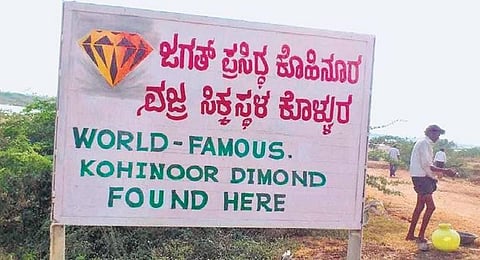

KALABURAGI : While stories abound on the origin of the famed ‘Kohinoor (Koh-i-Noor)’, the diamond mined in the Deccan and which is now part of the British crown jewels, the claim that the Kohinoor was mined in Kollur, a tiny village in Shahapur taluk of Yadgir district, is gaining traction. The Karnataka government is likely to take steps to check this claim and make the spot a tourist centre.
A Shahapur-based senior advocate, Bhaskar Rao Mudbool, who is also convener of the Kohinoor Smaraka Hitarakshana Samithi and president of Surpur Itihasa Samshodhana Kendra (Surpur History Research Centre) at Shahapur, is striving to convince the government on the necessity of setting up a memorial at the place where the world-famous diamond is said to have been mined.
Mudbool met Tourism Minister H K Patil during his visit to Shahapur on November 9, and briefed him about the fascinating story of Kohinoor, besides presenting some documents to support the claim that the diamond was mined in Kollur, on the banks of the river Krishna.
Rao presented documents, including the book ‘A Forgotten Empire (Vijayanagar) -- A Contribution to the History of India’ written by Robert Sewell, which said the Kohinoor was mined at Kollur, probably in 1656 AD. Mir Jumla, a Persian immigrant, owned the mine and farmed the diamond, which he presented to Emperor Shah Jahan. The uncut diamond is said to have weighed 756 carats.
In the book ‘Koh-i-Noor: The History of the World’s Most Infamous Diamond’ written by William Dalrymple and Anita Anand, it has been said that “it was presented uncut at 900 ratis or 787 carats” and came from the mines of Kollur in Karnataka.
Rao said the then tahsildar of Shahapur, in his letter K/ Bhumi/98/2009-10 dated 27-01-2011, had said there is a diamond mine in the depths of the banks of the Krishna, and imposed prohibition on sand mining from Markal village to Sangam (D) village in private and government lands.
Looking at these facts, the Samiti members have erected a board, stating that the Koh-i-noor was found there.“The government should acquire this place and develop a beautiful garden, and set up a pillar with a replica of Koh-i-Noor atop it,” Rao demanded.
Kohinoor’s travels
Nadir Shah, who ransacked Delhi in 1739, took away the diamond to Persia, and from there it reached Kabul, and finally came into the hands of Maharaja Ranjit Singh, the ruler of the Punjab, in 1813.
Ranjit Singh often wore the famous Kohinoor, meaning ‘Mountain of Light’, which was coveted by the British. After his death in 1839, it was placed in the jewel chamber till the infant Duleep Singh was acknowledged as Ranjit’s successor. In 1849, it was handed over to Sir John Lawrence on the annexation of the Punjab, and reached the Queen of England. It now weighs 106 1/16 carats, says the author Robert Swell.